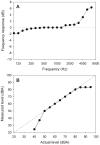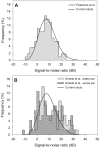Characteristics of Real-World Signal to Noise Ratios and Speech Listening Situations of Older Adults With Mild to Moderate Hearing Loss
- PMID: 29466265
- PMCID: PMC5824438
- DOI: 10.1097/AUD.0000000000000486
Characteristics of Real-World Signal to Noise Ratios and Speech Listening Situations of Older Adults With Mild to Moderate Hearing Loss
Abstract
Objectives: The first objective was to determine the relationship between speech level, noise level, and signal to noise ratio (SNR), as well as the distribution of SNR, in real-world situations wherein older adults with hearing loss are listening to speech. The second objective was to develop a set of prototype listening situations (PLSs) that describe the speech level, noise level, SNR, availability of visual cues, and locations of speech and noise sources of typical speech listening situations experienced by these individuals.
Design: Twenty older adults with mild to moderate hearing loss carried digital recorders for 5 to 6 weeks to record sounds for 10 hours per day. They also repeatedly completed in situ surveys on smartphones several times per day to report the characteristics of their current environments, including the locations of the primary talker (if they were listening to speech) and noise source (if it was noisy) and the availability of visual cues. For surveys where speech listening was indicated, the corresponding audio recording was examined. Speech-plus-noise and noise-only segments were extracted, and the SNR was estimated using a power subtraction technique. SNRs and the associated survey data were subjected to cluster analysis to develop PLSs.
Results: The speech level, noise level, and SNR of 894 listening situations were analyzed to address the first objective. Results suggested that as noise levels increased from 40 to 74 dBA, speech levels systematically increased from 60 to 74 dBA, and SNR decreased from 20 to 0 dB. Most SNRs (62.9%) of the collected recordings were between 2 and 14 dB. Very noisy situations that had SNRs below 0 dB comprised 7.5% of the listening situations. To address the second objective, recordings and survey data from 718 observations were analyzed. Cluster analysis suggested that the participants' daily listening situations could be grouped into 12 clusters (i.e., 12 PLSs). The most frequently occurring PLSs were characterized as having the talker in front of the listener with visual cues available, either in quiet or in diffuse noise. The mean speech level of the PLSs that described quiet situations was 62.8 dBA, and the mean SNR of the PLSs that represented noisy environments was 7.4 dB (speech = 67.9 dBA). A subset of observations (n = 280), which was obtained by excluding the data collected from quiet environments, was further used to develop PLSs that represent noisier situations. From this subset, two PLSs were identified. These two PLSs had lower SNRs (mean = 4.2 dB), but the most frequent situations still involved speech from in front of the listener in diffuse noise with visual cues available.
Conclusions: The present study indicated that visual cues and diffuse noise were exceedingly common in real-world speech listening situations, while environments with negative SNRs were relatively rare. The characteristics of speech level, noise level, and SNR, together with the PLS information reported by the present study, can be useful for researchers aiming to design ecologically valid assessment procedures to estimate real-world speech communicative functions for older adults with hearing loss.
Figures







Similar articles
-
Sound localization in noise by normal-hearing listeners and cochlear implant users.Ear Hear. 2012 Jul-Aug;33(4):445-57. doi: 10.1097/AUD.0b013e318257607b. Ear Hear. 2012. PMID: 22588270 Free PMC article.
-
The Effect of Signal to Noise Ratio on Cortical Auditory-Evoked Potentials Elicited to Speech Stimuli in Infants and Adults With Normal Hearing.Ear Hear. 2018 Mar/Apr;39(2):305-317. doi: 10.1097/AUD.0000000000000487. Ear Hear. 2018. PMID: 28863034
-
The Effect of Signal-to-Noise Ratio on Linguistic Processing in a Semantic Judgment Task: An Aging Study.J Am Acad Audiol. 2017 Mar;28(3):209-221. doi: 10.3766/jaaa.16025. J Am Acad Audiol. 2017. PMID: 28277212
-
Assessing and Modeling Spatial Release From Listening Effort in Listeners With Normal Hearing: Reference Ranges and Effects of Noise Direction and Age.Trends Hear. 2022 Jan-Dec;26:23312165221129407. doi: 10.1177/23312165221129407. Trends Hear. 2022. PMID: 36285532 Free PMC article. Review.
-
Benefits of auditory training for aided listening by older adults.Am J Audiol. 2013 Dec;22(2):335-8. doi: 10.1044/1059-0889(2013/12-0080). Am J Audiol. 2013. PMID: 23975126 Free PMC article. Review.
Cited by
-
The Type of Noise Influences Quality Ratings for Noisy Speech in Hearing Aid Users.J Speech Lang Hear Res. 2020 Dec 14;63(12):4300-4313. doi: 10.1044/2020_JSLHR-20-00156. Epub 2020 Nov 30. J Speech Lang Hear Res. 2020. PMID: 33253602 Free PMC article.
-
Does the Speech Cue Profile Affect Response to Amplitude Envelope Distortion?J Speech Lang Hear Res. 2021 Jun 4;64(6):2053-2069. doi: 10.1044/2021_JSLHR-20-00481. Epub 2021 May 21. J Speech Lang Hear Res. 2021. PMID: 34019777 Free PMC article.
-
The Acoustic Environments in Which Older Adults Wear Their Hearing Aids: Insights From Datalogging Sound Environment Classification.Am J Audiol. 2018 Dec 6;27(4):594-603. doi: 10.1044/2018_AJA-18-0061. Am J Audiol. 2018. PMID: 30267099 Free PMC article.
-
Effects of entropy in real-world noise on speech perception in listeners with normal hearing and hearing lossa).J Acoust Soc Am. 2023 Dec 1;154(6):3627-3643. doi: 10.1121/10.0022577. J Acoust Soc Am. 2023. PMID: 38051522 Free PMC article.
-
Acoustic Realism of Clinical Speech-in-Noise Testing: Parameter Ranges of Speech-Likeness, Interaural Coherence, and Interaural Differences.Trends Hear. 2025 Jan-Dec;29:23312165251336625. doi: 10.1177/23312165251336625. Epub 2025 May 6. Trends Hear. 2025. PMID: 40329585 Free PMC article.
References
-
- ANSI. Specification for audiometers (ANSI S3.6) New York: American national standards institute; 2010.
-
- Byrne DC, Reeves ER. Analysis of nonstandard noise dosimeter microphone positions. J Occup Environ Hyg. 2008;5:197–209. - PubMed
-
- Cox RM, Alexander GC, Gilmore C. Development of the Connected Speech Test (CST) Ear Hear. 1987a;8:119s–126s. - PubMed
-
- Cox RM, Alexander GC, Gilmore C. Intelligibility of average talkers in typical listening environments. J Acoust Soc Am. 1987b;81:1598–1608. - PubMed
Publication types
MeSH terms
Grants and funding
LinkOut - more resources
Full Text Sources
Other Literature Sources
Medical
Miscellaneous

